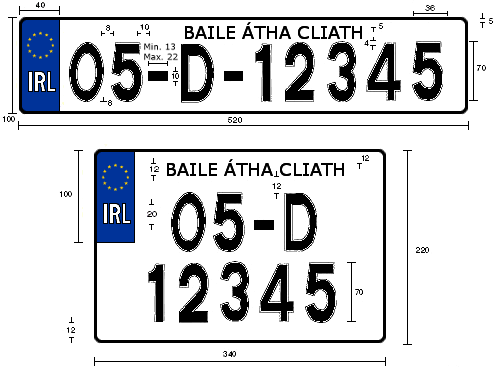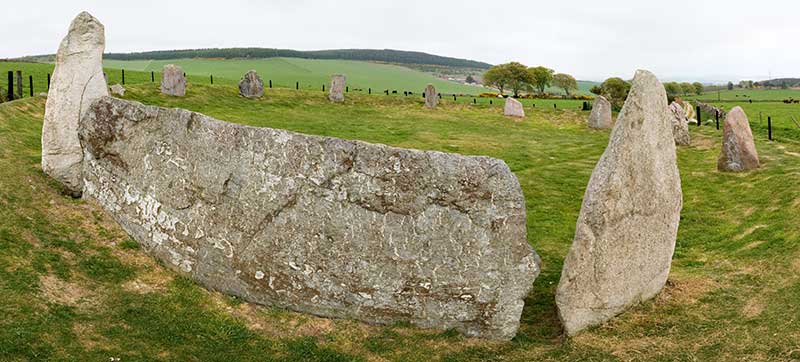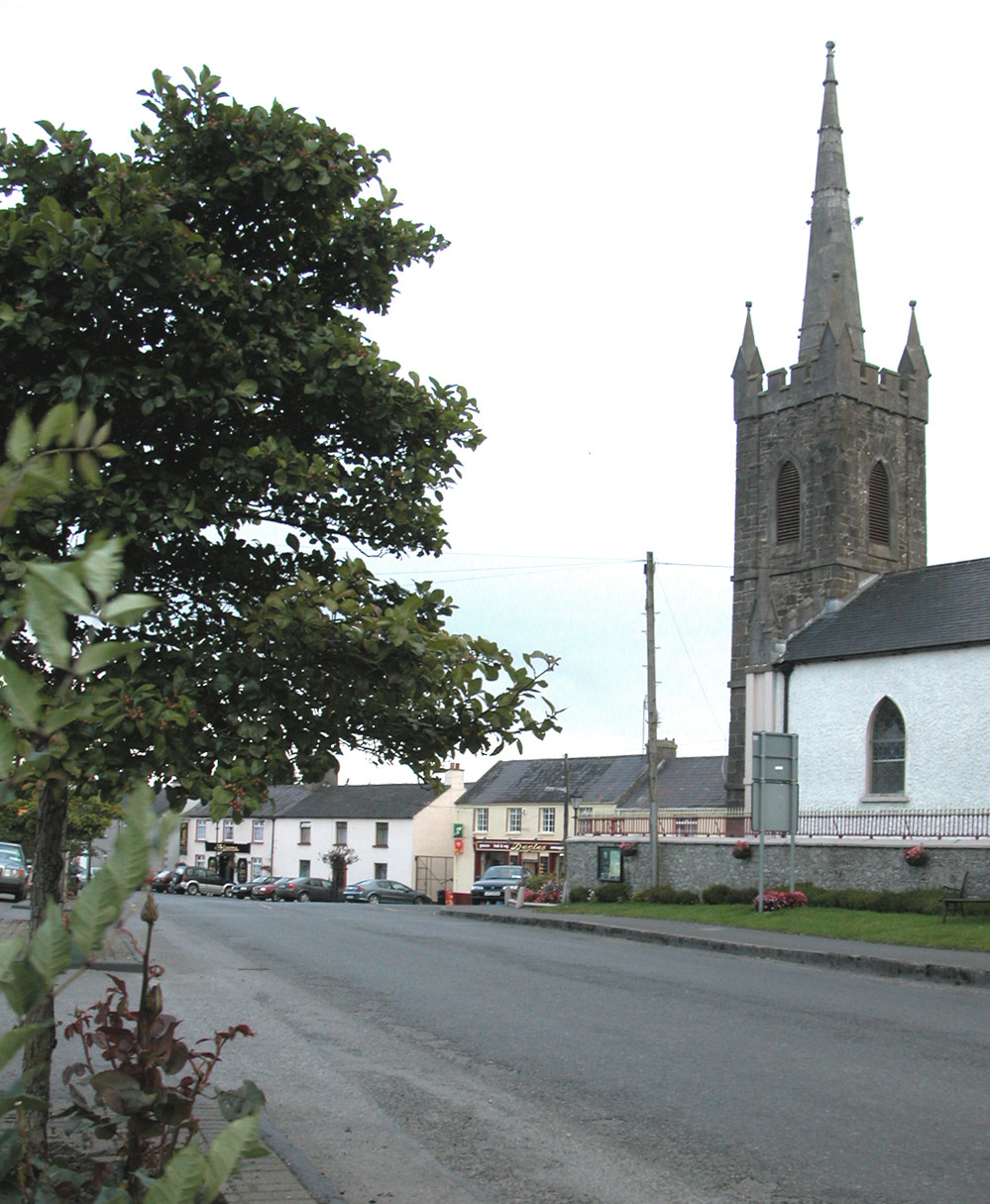|
Leix
County Laois ( ; ) is a county in Ireland. It is part of the Eastern and Midland Region and in the province of Leinster. It was known as Queen's County from 1556 to 1922. The modern county takes its name from Loígis, a medieval kingdom. Historically, it has also been known as County Leix. Laois County Council is the local authority for the county, and is based in Portlaoise. At the 2022 census, the population of the county was 91,657, an increase of 56% since the 2002 census. History Prehistoric The first people in Laois were bands of hunters and gatherers who passed through the county about 8,500 years ago. They hunted in the forests that covered Laois and fished in its rivers, gathering nuts and berries to supplement their diets. Next came Ireland's first farmers. These people of the Neolithic period (4000 to 2500 BC) cleared forests and planted crops. Their burial mounds remain in Clonaslee and Cuffsborough. Starting around 2500 BC, the people of the Bronze Age lived in ... [...More Info...] [...Related Items...] OR: [Wikipedia] [Google] [Baidu] |
Loígis
Loígis () is the name of an Irish tribe, as it is called by contemporary scholars. Formerly, scholars generally called the tribe ''Laoighis'' or ''Laeighis'' in Irish, ''Lagisia'' in Latin, and ''Leix'' in English. Loígis is also the name of the territory in western Leinster that the tribe settled during the third century AD, and of the minor kingdom that the Loígis chieftains ruled until 1608. County Laois derives its name from Loígis, although the present county encompasses baronies that were not traditionally part of the territory of Loígis. Background The name Loígis stems from the name of the tribe's first chieftain, Laigse(a)ch, Laeighsech, or Loígsech. Historical texts render that chieftain's full name variously as Lugaid Laigsech; Lugaid Loígsech Cennmár; Lugaid Laigseach, and Laigsech Ceandmar. One nineteenth-century analysis says that Laeighsech Cenn-mor and Lugaidh Laeighsech were actually two distinct individuals, the former being the father of the latter. L ... [...More Info...] [...Related Items...] OR: [Wikipedia] [Google] [Baidu] |
Counties Of Ireland
The counties of Ireland (Irish language, Irish: ) are historic administrative divisions of the island. They began as Normans in Ireland, Norman structures, and as the powers exercised by the Cambro-Norman barons and the Old English (Ireland), Old English nobility waned over time, new offices of political control came to be established at a county level. The number of counties varied depending on the time period, however thirty-two is the traditionally accepted and used number. Upon the partition of Ireland in 1921, six of the traditional counties became part of Northern Ireland. In Northern Ireland, Counties of Northern Ireland, counties ceased to be used for local government in 1973; Local government in Northern Ireland, districts are instead used. In the Republic of Ireland, some counties have been split resulting in the creation of new counties: there are currently 26 counties, 3 cities and 2 cities and counties that demarcate areas of local government in the Republic of Ire ... [...More Info...] [...Related Items...] OR: [Wikipedia] [Google] [Baidu] |
Counties Of Leix And Offaly Act 1556
The Settlement of Laois and Offaly Act 1556 (3 & 4 Phil. & Mar. c. 2 (I)) was an Act of the Parliament of Ireland passed in 1556 which resulted in the creation of Queen's County and King's County in the midlands of Ireland, and the establishment of two shire towns at ''Maryborough'' (Portlaoise) and ''Philipstown'' ( Daingean), named in honour of Queen Mary I and King Phillip II. The act was the first Tudor attempt at plantation in Ireland and was designed to formally open up the area to English settlement. The act displaced the ruling O'More (or Moore) clan of Loígis and the O'Connor rulers of the Kingdom of Uí Failghe by declaring their lands to be the legal possession of the English monarch. In 1922, ''Queen's County'' was renamed Laois and ''King's County'' was renamed Offaly. The act was repealed by Dáil Éireann Dáil Éireann ( ; , ) is the lower house and principal chamber of the Oireachtas, which also includes the president of Ireland and a senate call ... [...More Info...] [...Related Items...] OR: [Wikipedia] [Google] [Baidu] |
Vehicle Registration Plates Of Ireland
In Ireland, vehicle registration plates (commonly known as "number plates" or "registration plates") are the visual indications of motor vehicle registration which has been mandatory since 1903 to display on most motor vehicles used on public roads in Ireland. The alphanumeric marks (or "registration numbers", officially termed "identification marks") themselves are issued by the local authority in which a vehicle is first registered. Format The current specification for number plates is the format YYY–CC–SSSSSS. Those issued from 1987 to 2012 had the format YY–CC–SSSSSS. The components are: * YYY or YY – an age/year identifier. This is based on date of first registration. * CC – a one or two-character county/city identifier (e.g. L for Limerick City and County; SO for County Sligo). * SSSSSS – a one to six-digit sequence number, starting with the first vehicle registered in the county/city that year/period. Year identifiers The YY format was used between ... [...More Info...] [...Related Items...] OR: [Wikipedia] [Google] [Baidu] |
Portlaoise
Portlaoise ( ), or Port Laoise (), is the county town of County Laois, Republic of Ireland, Ireland. It is in the Midland Region, Ireland, South Midlands in the province of Leinster. Portlaoise was the fastest growing of the top 20 largest towns and cities in Ireland from 2011 to 2016. However, the 2022 census of Ireland, 2022 census shows that the town's population increased by 6.6% to 23,494, which was below the national average of 8%. It is the most populous and also the most densely populated town in the Midland Region, Ireland, Midland Region, which has a total population of 317,999 at the 2022 census of Ireland, 2022 census. It was an important town in the sixteenth century, as the site of the Fort of Maryborough, a fort built by English settlers during the Plantations of Ireland#Early plantations (1556–1576), Plantation of Queen's County. Portlaoise is fringed by the Slieve Bloom Mountains, Slieve Bloom mountains to the west and north-west and the Great Heath of Mary ... [...More Info...] [...Related Items...] OR: [Wikipedia] [Google] [Baidu] |
Eircode
A postal address in Ireland is a place of Delivery (commerce), delivery defined by Irish Standard (IS) EN 14142-1:2011 ("Postal services. Address databases") and serviced by the universal service provider, . Its addressing guides comply with the guidelines of the Universal Postal Union (UPU), the United Nations-affiliated body responsible for promoting standards in the postal industry, across the world. In Ireland, 35% of premises (over 600,000) have non-unique addresses due to an absence of house numbers or names. Before the introduction of a national postcode system (Eircode) in 2015, this required postal workers to remember which family names corresponded to which house in smaller towns, and many townlands. , An Post encourages customers to use Eircode because it ensures that their post person can pinpoint the exact location. Ireland was the last country in the OECD to create a postcode system. In July 2015 all 2.2 million residential and business addresses in Ireland r ... [...More Info...] [...Related Items...] OR: [Wikipedia] [Google] [Baidu] |
Regions Of Ireland
Ireland uses the Nomenclature of Territorial Units for Statistics (NUTS) geocode standard for referencing country subdivisions for statistical purposes. The standard is developed and regulated by the European Union. The NUTS standard is instrumental in delivering European Structural and Investment Funds. The NUTS code for Ireland is ''IE'' and a hierarchy of three levels is established by Eurostat. A further level of geographic organisation, the local administrative unit (LAU), in Ireland is the local electoral area. Overview NUTS levels 1, 2 and 3 The most recent revision of NUTS regions was made in 2016 and took effect in 2018. The eligibility of regions for funding under the European Regional Development Fund and the European Social Fund Plus was revised in 2021. NUTS 2 Regions may be classified as less developed regions, transition regions, or more developed regions. Demographic statistics by NUTS 3 region Local administrative units The local administrative unit ... [...More Info...] [...Related Items...] OR: [Wikipedia] [Google] [Baidu] |
Cashel Man
Cashel Man is a bog body found near Cashel in County Laois, Ireland, on 10 August 2011. The body was a young adult male, around 20–25,Hart, Edward, dir. "Ghosts of Murdered Kings." NOVA. Prod. Edward Hart and Dan McCabe. PBS. 29 Jan. 2014. Television. who had been intentionally covered with peat after death. The crouched figure was recovered after being damaged by a milling machine in 2011. The head and left arm were presumed destroyed by the peat harvester until later recovered. Radiocarbon dating places the man as having died around 2000 BC, making him one of the oldest bog bodies in Europe. Position at discovery Cashel Man was found lying on his right side with his legs tightly flexed. The body was in the middle of the bog, oriented north-to-south with his head pointing south. There was not much other information available because the head, neck and left arm were all removed from the body by the peat Peat is an accumulation of partially Decomposition, decayed veg ... [...More Info...] [...Related Items...] OR: [Wikipedia] [Google] [Baidu] |
Borris-in-Ossory
Borris-in-Ossory (, or the ' Burgage of Osraige') is a village in west County Laois, Ireland, close to the Tipperary border and the M7 motorway. Features The village has facilities such as a school, churches, community hall, convenience retail outlets and a number of service businesses. The village centre comprises Main Street and includes retail, commercial, institutional, educational and residential functions. Landmark buildings include the Hiberno Romanesque Church of Ireland church of St. Mark, built c.1870, with round tower style bell tower, St. Canice's Church (Roman Catholic), the Ossory of Borris-in-Ossory, and former courthouse. The renovated O’Brien Hall is used as a meeting place for the village's Youth Club and other activities. Transport Roads The village is on the R445 road between the towns of Mountrath (13 km east along the R445) and Roscrea (12 km west). During 2009 a motorway junction was constructed to the south of the village in preparation ... [...More Info...] [...Related Items...] OR: [Wikipedia] [Google] [Baidu] |
Stone Circle
A stone circle is a ring of megalithic standing stones. Most are found in Northwestern Europe – especially Stone circles in the British Isles and Brittany – and typically date from the Late Neolithic and Early Bronze Age, with most being built between 3300 and 2500 BC. The best known examples include those at the henge monument at Avebury, the Rollright Stones, Castlerigg, and elements within the ring of standing stones at Stonehenge. Scattered examples exist from other parts of Europe. Later, during the Iron Age, stone circles were built in southern Scandinavia. The archetypical stone circle is an uncluttered enclosure, large enough to congregate inside, and composed of megalithic stones. Often similar structures are named 'stone circle', but these names are either historic, or incorrect. Examples of commonly misinterpreted stone circles are ring cairns, burial mounds, and kerb cairns. Although it is often assumed there are thousands of stone circles across the Br ... [...More Info...] [...Related Items...] OR: [Wikipedia] [Google] [Baidu] |
Clonaslee
Clonaslee () is a village in north County Laois, Ireland, situated in the foothills of the Slieve Bloom Mountains on the R422 Mountmellick to Birr road. Clonaslee is approximately 100 km west of Dublin, and is close to the towns of Portlaoise and Tullamore. As of the 2022 census, the village had a recorded population of 608. Name The primary spelling of the name, Clonaslee, is associated by several sources to the Irish ''Cluain na Slí'' (translated as "pasture of the way" or "roadside meadow" or similar) and related to the village's location on ancient cross-country route. Though this is the commonly and officially accepted version, an alternative spelling of the name, Cloneslieu, is associated by some sources to the Irish ''Cluain na Sléibhe'' (translated as "the mountain meadow"). The original name of the parish, Kilmanman, from the Irish ''Cill na mBanbhán'' or ''Cill Mheanman'' (translated as "the church of Manman"), is associated with Saint Manman who founde ... [...More Info...] [...Related Items...] OR: [Wikipedia] [Google] [Baidu] |
Arderin
Arderin () is a mountain on the border between counties Laois and Offaly in Ireland Ireland (, ; ; Ulster Scots dialect, Ulster-Scots: ) is an island in the North Atlantic Ocean, in Northwestern Europe. Geopolitically, the island is divided between the Republic of Ireland (officially Names of the Irish state, named Irelan .... With a height of 527 metres (1,729 ft) it is the highest point in the Slieve Bloom Mountains, and is the highest point in both counties. An Arderin is also a descriptive word for a specific category of Irish mountains in the series of lists maintained by Irish mountain database, MountainViews; those over 500m with a prominence of at least 30m. This list, along with other complementary ones, has been published in book form by Collins Press.Mountainviews, (2013), "A Guide to Ireland's Mountain Summits: The Vandeleur-Lynams & the Arderins", Collins Books, Cork, Mountainviews.ie classifies a mountain as being above 500m, but also maintai ... [...More Info...] [...Related Items...] OR: [Wikipedia] [Google] [Baidu] |








